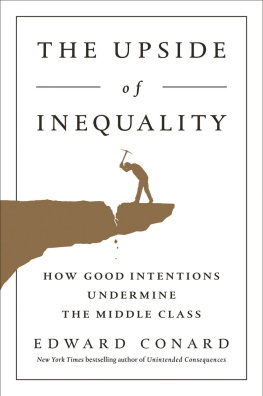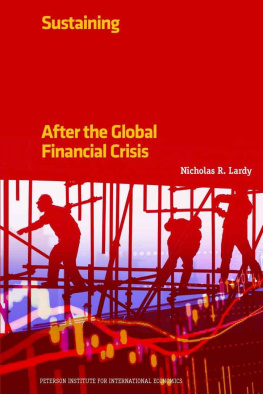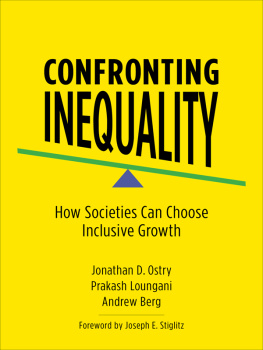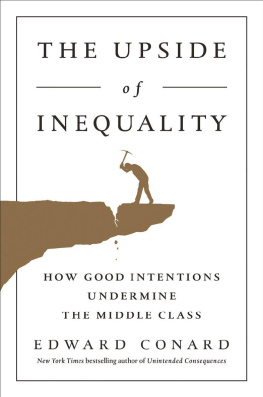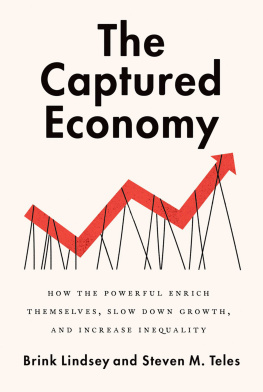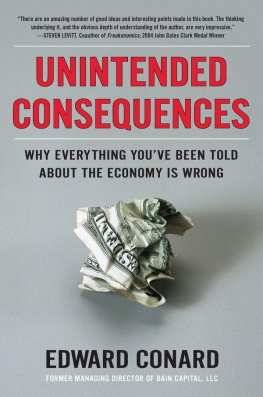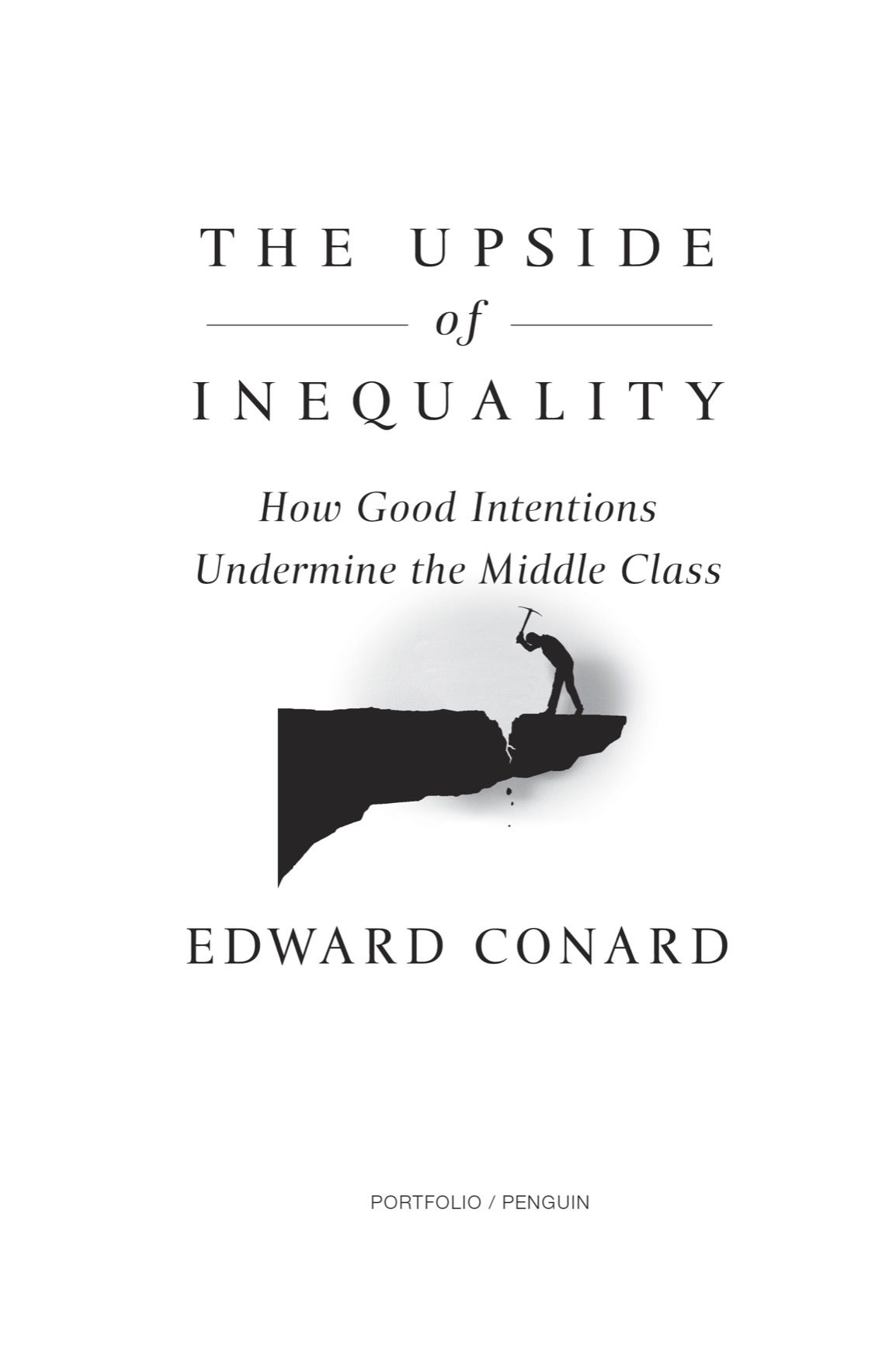Conard provides a much-needed reappraisal of the role of inequality in a free-market economy. The most crucial insight of economics is that incentives matter, and those incentives will inevitably show up as an unequal distribution of economic resources. Conard argues forcefully that the well-intentioned policies of reducing inequality in the short term are not necessarily beneficial in the long term, as inequality and economic growth are closely linked.
George J. Borjas, Robert W. Scrivner professor of economics and social policy, Harvard Kennedy School, and author of Labor Economics and Immigration Economics
Ed Conard reminds us that inequality sends a signal of what society lacks most; in Americas case, entrepreneurship and risk-taking . That is why it is highly rewarded. Intellectual and political attacks on those who use these attributes will prove to be counterproductive.
Lawrence Lindsey, CEO of the Lindsey Group LLC and former director of the National Economic Council
In this significant contribution to economic thought , Ed Conard extends our theory that equity and risk-underwriting constrain growth and uses it to identify important consequences for economic policy.
Bruce Greenwald, coauthor (with Joseph Stiglitz) of A New Paradigm in Monetary Theory, and Robert Heilbrunn professor of finance, Columbia Business School
Economists tend to be enslaved by their models, and too often their work is obscure, unimaginative, and irrelevant. Conards visionary take on the constraints to growth and their effect on inequality is nothing short of revolutionary .
Kevin Hassett, resident scholar and director of research for domestic policy, American Enterprise Institute
For my wife and daughter,
my mother, who died this year,
and my sister, who kept her alive.

An imprint of Penguin Random House LLC
375 Hudson Street
New York, NY 10014

Copyright 2016 by Coherent Research Institute, Inc.
Penguin supports copyright. Copyright fuels creativity, encourages diverse voices, promotes free speech, and creates a vibrant culture. Thank you for buying an authorized edition of this book and for complying with copyright laws by not reproducing, scanning, or distributing any part of it in any form without permission. You are supporting writers and allowing Penguin to continue to publish books for every reader.
ISBN 9781595231239 (hardcover)
ISBN 9780698409910 (e-book)
Version_2
INTRODUCTION
I wrote Unintended Consequences in 2012 because I was concerned that in the aftermath of the financial crisis misguided economic policy would lead to slower-than-necessary growth. The financial crisis had called the value of free enterprise into question in the mind of the public, and I wanted to set the record straight.
The U.S. economy had grown robustly for nearly two decades leading up to the financial crisis. But the U.S. economy ran enormous trade deficits with China, Germany, and Japaneconomies with large surpluses of risk-averse savings. These economies used risk-averse savings to fund large trade surpluses that indirectly necessitated large increases in U.S. borrowing and lendingchiefly subprime mortgagesto maintain full employment. This expansion of credit destabilized U.S. banks. When real estate prices fell 30 percent, it sparked a panicked run on an inherently unstable banking system.
Rather than diagnosing the problems properly, demagogues on the left and right claimed that ill-advised monetary policy, misguided regulation, and debt-fueled growthfraudulently devised by reckless bankershad created unsustainable prosperity. The public bought those views despite two decades of historic U.S. productivity growth that could only have been achieved with hard-earned investment, risk-taking, and innovation.
In Unintended Consequences, I explained why the U.S. economy was gradually growing more productive than Europe and Japannamely, because higher payoffs for successful risk-taking were gradually building U.S. institutional capabilities. More valuable on-the-job training, large synergistic communities of experts, highly motivated and trained talent, and equity in the hands of eager risk-takers had compounding effects on the value of successful risk-taking. I recommended lower marginal tax rates to maintain higher payoffs in the face of slower growth in the aftermath of the financial crisis. The Obama administration did the opposite.
I cautioned that holding the banks responsible for bank runs, instead of just loan losses, at a time when they were already reluctant to lend, would slow growth. I recommended strengthening government guarantees of banks and the Feds ability to function as the lender of last resort but charging banks and borrowers for these guarantees. The Obama administration did the opposite.
Most Keynesian economists insisted that the government need only borrow and spend idle savings to create growing demand. They also claimed that a credible threat of inflation would accelerate growth by discouraging unused savings that slow growth. I predicted that constraints to growth would prevent these policies from having positive long-term effects and that the private sector would dial back risk-taking in response to these policies, slowing growth further. I argued that America should not distort the economy by inflating the money supply to discourage saving nor increase unproductive government borrowing and spending in an effort to put unused risk-averse offshore savings to work. Instead, I recommended that the country should deal with the problem of idle savings directlyby demanding balanced trade with trade partners like China, Germany, and Japan. While trade is critical for growth, trade deficits are not. The Obama administration did the opposite.
To foster growth, the U.S. government borrowed and spent $6 trillion and inflated the money supply four-fold in order to buy another $3 trillion of privately held financial securities. Perhaps the recession would have been worse without these efforts, but eight years after the financial crisis, growth remains anemic and productivity growth has fallen to historic lows. Financial crises likely slow recoveries, but eventually the economy rebounds. No rebound ever materialized, nor is one in sight. Instead, slow productivity growth portends continued difficulties. While its true that institutional capabilities allowed the U.S. economy to recover faster than other high-wage economies, they were already producing faster growth in the two decades prior to the recession.
Because my business partner, Mitt Romney, was running for president when Unintended Consequences was published, the media held up my book as a defense of the 1 percent. At the time, a leading proponent of income redistribution wrote, the biggest surprise, on opening Unintended Consequences, lies in discovering that this book isnt about income inequality at all. The critics demand for a comprehensive defense of income inequality planted the seeds for this book.
Since 2012, accusations that crony capitalism and the success of the 1 percent slow middle- and working-class income growth have only grown louder. While the incomes of the 0.1 percent have soared, the growth of middle-class and working-class incomes has continued to remain slow. Many insist that this gap has grown because the wealthy are rigging a zero-sum game to take what rightly belongs to others.

